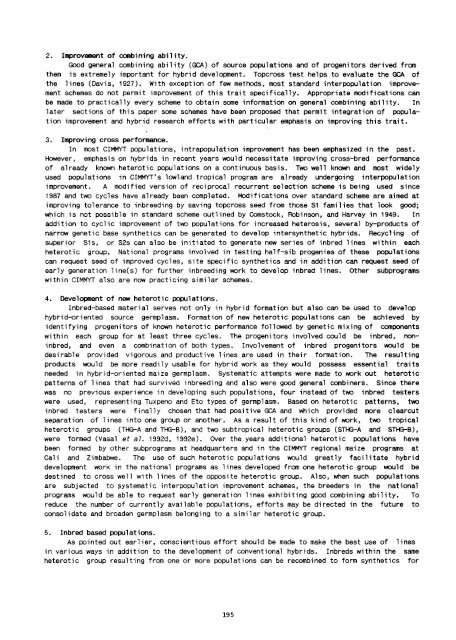Proceedings of the Fifth Asian Regional Maize Workshop - Search ...
Proceedings of the Fifth Asian Regional Maize Workshop - Search ...
Proceedings of the Fifth Asian Regional Maize Workshop - Search ...
Create successful ePaper yourself
Turn your PDF publications into a flip-book with our unique Google optimized e-Paper software.
2. Improvement <strong>of</strong> combining ability.<br />
Good general combining ability (GCA) <strong>of</strong> source populations and <strong>of</strong> progenitors derived from<br />
<strong>the</strong>m is extremely important for hybrid development. Topcross test helps to evaluate <strong>the</strong> GCA <strong>of</strong><br />
<strong>the</strong> lines (Davis, 1927). With exception <strong>of</strong> few methods, most standard interpopulation improvement<br />
schemes do not permit improvement <strong>of</strong> this trait specifically. Appropriate modifications can<br />
be made to practically every scheme to obtain some information on general combining ability. In<br />
later sections <strong>of</strong> this paper some schemes have been proposed that permit integration <strong>of</strong> population<br />
improvement and hybrid research efforts with particular emphasis on improving this trait.<br />
3. Improvi ng cross performance.<br />
In most CIMMYT populations, intrapopulation improvement has been emphasized in <strong>the</strong> past.<br />
However, emphasis on hybrids in recent years would necessitate improving cross-bred performance<br />
<strong>of</strong> already known heterotic populations on a continuous basis. Two well known and most widely<br />
used populations in CIMMYT's lowland tropical program are already undergoing interpopulation<br />
improvement. A modified version <strong>of</strong> reciprocal recurrent selection scheme is being used since<br />
1987 and two cycles have already been completed. Modifications over standard scheme are aimed at<br />
improving tolerance to inbreeding by saving topcross seed from those S1 families that look good;<br />
which is not possible in standard scheme outlined by Comstock, Robinson, and Harvey in 1949. In<br />
addition to cyclic improvement <strong>of</strong> two populations for increased heterosis, several by-products <strong>of</strong><br />
narrow genetic base syn<strong>the</strong>tics can be generated to develop intersyn<strong>the</strong>tic hybrids. Recycling <strong>of</strong><br />
superior S1s, or S2s can also be initiated to generate new series <strong>of</strong> inbred lines within each<br />
heterotic group. National programs involved in testing half-sib progenies <strong>of</strong> <strong>the</strong>se populations<br />
can request seed <strong>of</strong> improved cycles, site specific syn<strong>the</strong>tics and in addition can request seed <strong>of</strong><br />
early generation line(s) for fur<strong>the</strong>r inbreeding work to develop inbred lines. O<strong>the</strong>r subprograms<br />
within CIMMYT also are now practicing similar schemes.<br />
4. Development <strong>of</strong> new heterotic populations.<br />
Inbred-based material serves not only in hybrid formation but also can be used to develop<br />
hybrid-oriented source germplasm. Formation <strong>of</strong> new heterotic populations can be achieved by<br />
identifying progenitors <strong>of</strong> known heterotic performance followed by genetic mixing <strong>of</strong> components<br />
within each group for at least three cycles. The progenitors involved could be inbred, noninbred,<br />
and even a combination <strong>of</strong> both types. Involvement <strong>of</strong> inbred progenitors would be<br />
desirable provided vigorous and productive lines are used in <strong>the</strong>ir formation. The resulting<br />
products would be more readily usable for hybrid work as <strong>the</strong>y would possess essential traits<br />
needed in hybrid-oriented maize germplasm. Systematic attempts were made to work out heterotic<br />
patterns <strong>of</strong> lines that had survived inbreeding and also were good general combiners. Since <strong>the</strong>re<br />
was no previous experience in developing such popUlations, four instead <strong>of</strong> two inbred testers<br />
were used, representing Tuxpeno and Eto types <strong>of</strong> germplasm. Based on heterotic patterns, two<br />
inbred testers were finally chosen that had positive GCA and which provided more clearcut<br />
separation <strong>of</strong> lines into one group or ano<strong>the</strong>r. As a result <strong>of</strong> this kind <strong>of</strong> work, two tropical<br />
heterotic groups (THG-A and THG-B) , and two subtropical heterotic groups (STHG-A and STHG-B) ,<br />
were formed (Vasal et aT. 1992d, 1992e). OVer <strong>the</strong> years additional heterotic populations have<br />
been formed by o<strong>the</strong>r subprograms at headquarters and in <strong>the</strong> CIMMYT regional maize programs at<br />
Cali and Zimbabwe. The use <strong>of</strong> such heterotic populations would greatly facilitate hybrid<br />
development work in <strong>the</strong> national programs as lines developed from one heterotic group would be<br />
destined to cross well with lines <strong>of</strong> <strong>the</strong> opposite heterotic group. Also, when such populations<br />
are subjected to ~ystematic interpopulation improvement schemes, <strong>the</strong> breeders in <strong>the</strong> national<br />
programs would be able to request early generation lines exhibiting good combining ability. To<br />
reduce <strong>the</strong> number <strong>of</strong> currently available populations, efforts may be directed in <strong>the</strong> future to<br />
consolidate and broaden germplasm belonging to a similar heterotic group.<br />
5. Inbred based populations.<br />
As pointed out earlier, conscientious effort should be made to make <strong>the</strong> best use <strong>of</strong> lines<br />
in various ways in addition to <strong>the</strong> development <strong>of</strong> conventional hybrids. Inbreds within <strong>the</strong> same<br />
heterotic group resulting from one or more populations can be recombined to form syn<strong>the</strong>tics for<br />
195

















